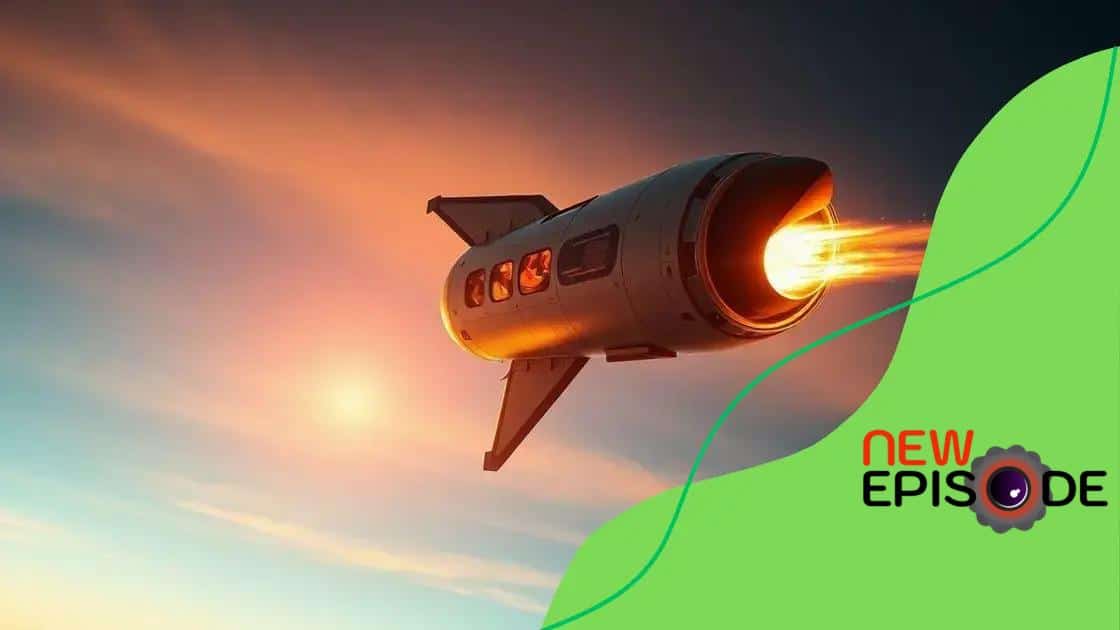How space tourism is becoming a commercial industry

Space tourism is rapidly evolving, with advancements in technology making trips more affordable and accessible, alongside increased safety measures and exciting new destinations for travelers.
How space tourism is becoming a commercial industry is an exciting development, drawing interest from travelers eager for unique experiences beyond our planet. Have you ever dreamed of seeing Earth from space? Let’s dive into this new frontier of travel.
The evolution of space tourism
The evolution of space tourism is a fascinating journey, marked by significant milestones that have brought us closer to exploring the cosmos. This industry has undergone remarkable changes over the years, with advancements in technology paving the way for commercial space travel.
Early Developments
In the early days, space travel was restricted to highly trained astronauts. However, companies began to envision a future where regular people could experience space. The idea took its first significant step when private companies entered the race to make space tourism a reality.
Key Milestones
- The launch of the first private spacecraft in the early 2000s marked a turning point.
- In 2007, the first commercial suborbital flights were sold to space tourists.
- In 2020, the SpaceX Crew Dragon successfully transported astronauts to the International Space Station, showcasing what private companies can achieve.
As technology advanced, the costs associated with space travel began to decrease, making it more accessible. Companies like SpaceX, Blue Origin, and Virgin Galactic have played crucial roles in driving the industry forward. These innovations include reusable rockets and improved safety measures, which are vital for instilling confidence in potential space travelers.
Future of Space Tourism
The future looks promising for space tourism. More companies are emerging, focusing on both suborbital and orbital flights. As more people express interest in experiencing the wonders of space, we can expect continued growth and innovation.
With plans for lunar tourism and even missions to Mars being discussed, the evolution of space tourism is just beginning. The possibilities are endless as we push the boundaries of exploration and commercial opportunities.
Key players in the commercial space industry
When discussing the key players in the commercial space industry, several companies emerge as leaders. These organizations are pushing the boundaries of space travel and making it more accessible to the public.
Major Companies
First, we have SpaceX, founded by Elon Musk. They are known for their innovative rockets and the successful launch of the first private spacecraft to the International Space Station. Blue Origin, created by Jeff Bezos, focuses on suborbital flights and aims to build a future where millions can live and work in space.
Other Influential Players
- Virgin Galactic is pioneering space tourism, enabling civilians to experience weightlessness.
- Axiom Space plans to build the first commercial space station, revolutionizing how we view space tourism.
- Rocket Lab focuses on small satellite launches, catering to the increasing demand for satellite deployment.
These companies are not just competitors; they often collaborate and drive innovation together. This teamwork leads to advancements like reusable rockets, which significantly lower costs and increase the frequency of launches.
As these companies continue to innovate, new players are likely to join the market, making the landscape of the commercial space industry more dynamic. From technology enhancements to customer experiences, the growth potential is enormous. These efforts not only benefit travelers but also contribute to research and development that could benefit humanity as a whole.
Challenges in the space tourism market

The space tourism market faces several challenges that must be addressed for it to thrive. One major hurdle is the high cost associated with space travel. The price of launching a spacecraft and ensuring safety makes it expensive for the average person. Advancements in technology are needed to lower these costs, making space travel more accessible.
Safety Concerns
Another significant challenge is ensuring safety. The potential risks of space travel deter many from considering it. Incidents involving test flights and the complexities of space physiology present serious concerns for both companies and potential travelers.
Regulatory Hurdles
- The regulatory environment for space travel is still developing.
- Companies often face delays in obtaining the necessary permits for launches.
- International regulations can complicate plans for space tourism.
Moreover, the public’s perception of space tourism plays a crucial role. Many still view it as a luxury only for the wealthy. To expand the market, companies must shift this perception and emphasize the benefits of space experiences.
Additionally, environmental concerns are becoming increasingly important. Launching rockets can have adverse effects on the environment, which raises questions about sustainability in the space tourism market. Companies need to explore greener technologies to mitigate this impact. As the sector grows, addressing these challenges is vital for creating a safe, accessible, and environmentally friendly space tourism experience.
Technological advancements in space travel
Technological advancements in space travel are rapidly transforming the landscape of this industry. Innovations are enabling more efficient, safer, and cost-effective journeys to space. These developments are crucial for making space tourism a reality for more people.
Reusable Rockets
One of the most significant breakthroughs is the creation of reusable rockets. Companies like SpaceX have pioneered this technology, allowing rockets to be launched, landed, and reused. This greatly reduces the cost of space missions and increases the frequency of launches.
Enhanced Safety Measures
- Advanced simulations for training astronauts are now commonplace.
- New safety protocols are being developed based on previous missions.
- Improved life support systems ensure a safer experience for travelers.
Moreover, advancements in propulsion systems, such as ion thrusters and electric propulsion, are changing how we navigate space. These technologies offer higher efficiency and allow spacecraft to travel longer distances with less fuel. This is essential for future missions to the Moon, Mars, and beyond.
Another important factor is the development of advanced materials. Lightweight and durable materials are being used to build spacecraft that can withstand the harsh conditions of space. These materials enhance the performance and safety of space vehicles, making them better suited for human travel.
Furthermore, innovations in artificial intelligence are improving navigation and operational procedures in space travel. AI systems can analyze data in real-time, assisting crew members and ensuring safe operations. As we look ahead, these technological advancements will continue to shape the future of space tourism and exploration.
Future prospects of space tourism
The future prospects of space tourism are promising and exciting, as the industry is set to grow rapidly. More people are showing interest in experiencing the wonders of space firsthand. Companies are investing heavily in technology and infrastructure to make this dream a reality.
Increased Accessibility
As technology advances, the cost of space travel is expected to decrease. This means that more individuals will be able to afford trips into space. With new developments, like hybrid launch systems and energy-efficient rockets, the barriers preventing access to space are lowering.
New Destinations
- Luxury space hotels are being planned, offering unique views of Earth.
- Missions to the Moon and Mars are on the horizon, expanding travel options.
- Suborbital flights will provide experiences of weightlessness and breathtaking views.
Furthermore, as commercial space stations become operational, travelers will have the opportunity to participate in scientific experiments alongside astronauts. This will deepen their understanding of space and its vast possibilities.
The collaboration between governments and private companies is another positive factor. This partnership will help overcome regulatory challenges and foster innovation. As more organizations join the race, competition will drive improvements in safety and experience.
The prospects for space tourism extend beyond just travel. Innovations in this sector can lead to advancements in various fields, such as materials science and communications. As the industry matures, it holds the potential to benefit humanity as a whole, paving the way for exploration and discovery.
In conclusion, the journey of space tourism is just beginning, with great potential for growth and innovation. As technology improves, more people will have the chance to explore the wonders of space. Major players in the industry are continuously working on overcoming challenges, making trips safer and more affordable. The future promises exciting new destinations, such as the Moon and beyond, along with unique experiences like luxury space hotels. With a collaborative spirit between governments and private companies, the dream of space travel is becoming a reality for many. As we look forward to these developments, the possibilities for exploration and discovery are endless.
FAQ – Frequently Asked Questions about Space Tourism
What is space tourism?
Space tourism refers to commercial activities where private individuals travel to space for recreational, leisure, or adventure purposes.
How much does a space tourism trip cost?
The cost of a space flight can vary widely, but currently, it ranges from hundreds of thousands to millions of dollars per person, depending on the experience.
What safety measures are in place for space tourists?
Companies prioritize safety by implementing rigorous training, using advanced technology, and adhering to strict regulations to ensure a safe journey.
When will space tourism become more accessible?
As technology advances and competition increases, the cost of space travel is expected to decrease, making it more accessible in the coming years.






